Accounting Students' Major Choice
VerifiedAdded on 2020/02/03
|9
|2426
|373
Literature Review
AI Summary
This assignment examines students' decision-making processes when choosing an accounting major, applying the Theory of Reasoned Action. It delves into research papers that investigate factors influencing this choice, drawing on diverse perspectives and methodologies. The analysis spans various areas, including the impact of parental praise, group dynamics, and ethical considerations in accounting.
Contribute Materials
Your contribution can guide someone’s learning journey. Share your
documents today.
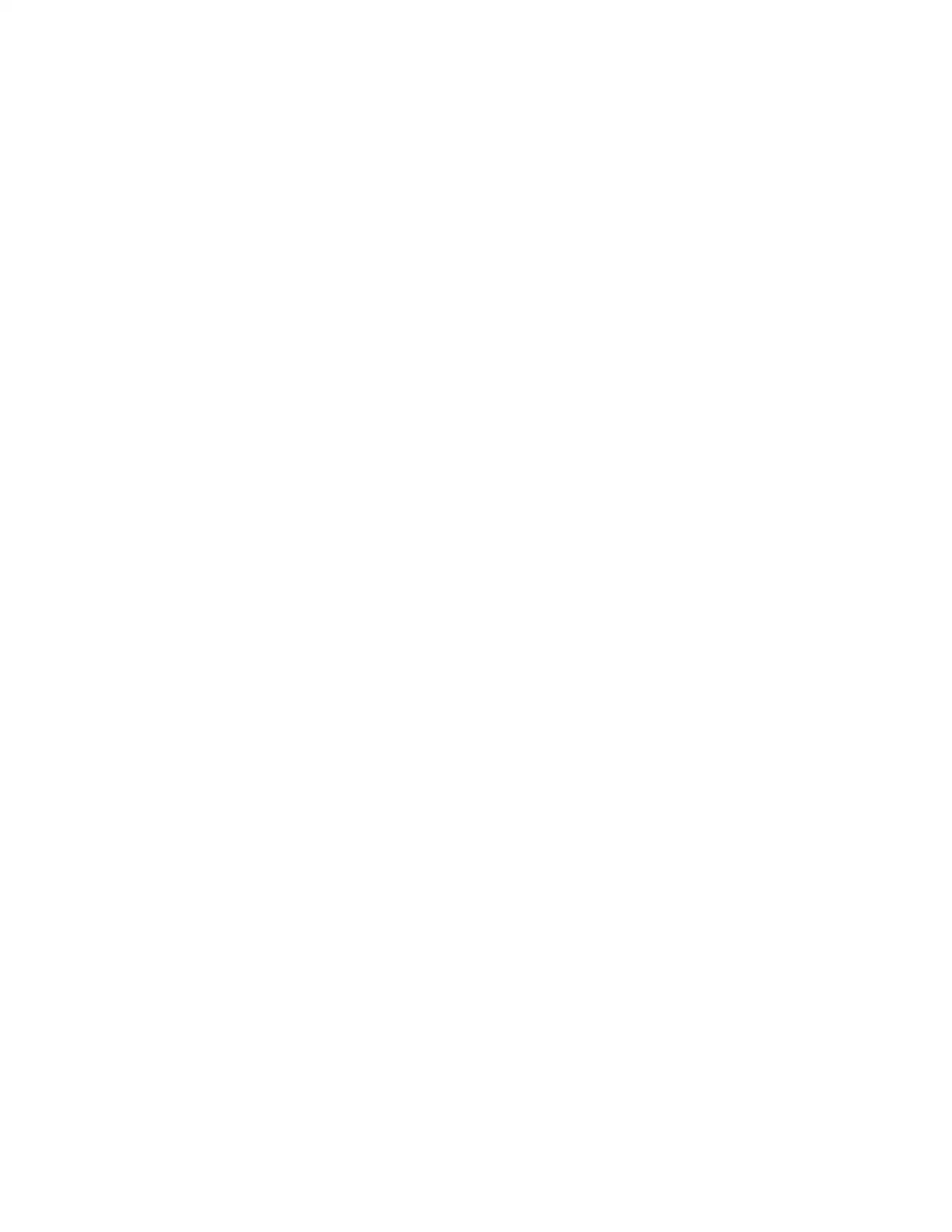
Secure Best Marks with AI Grader
Need help grading? Try our AI Grader for instant feedback on your assignments.
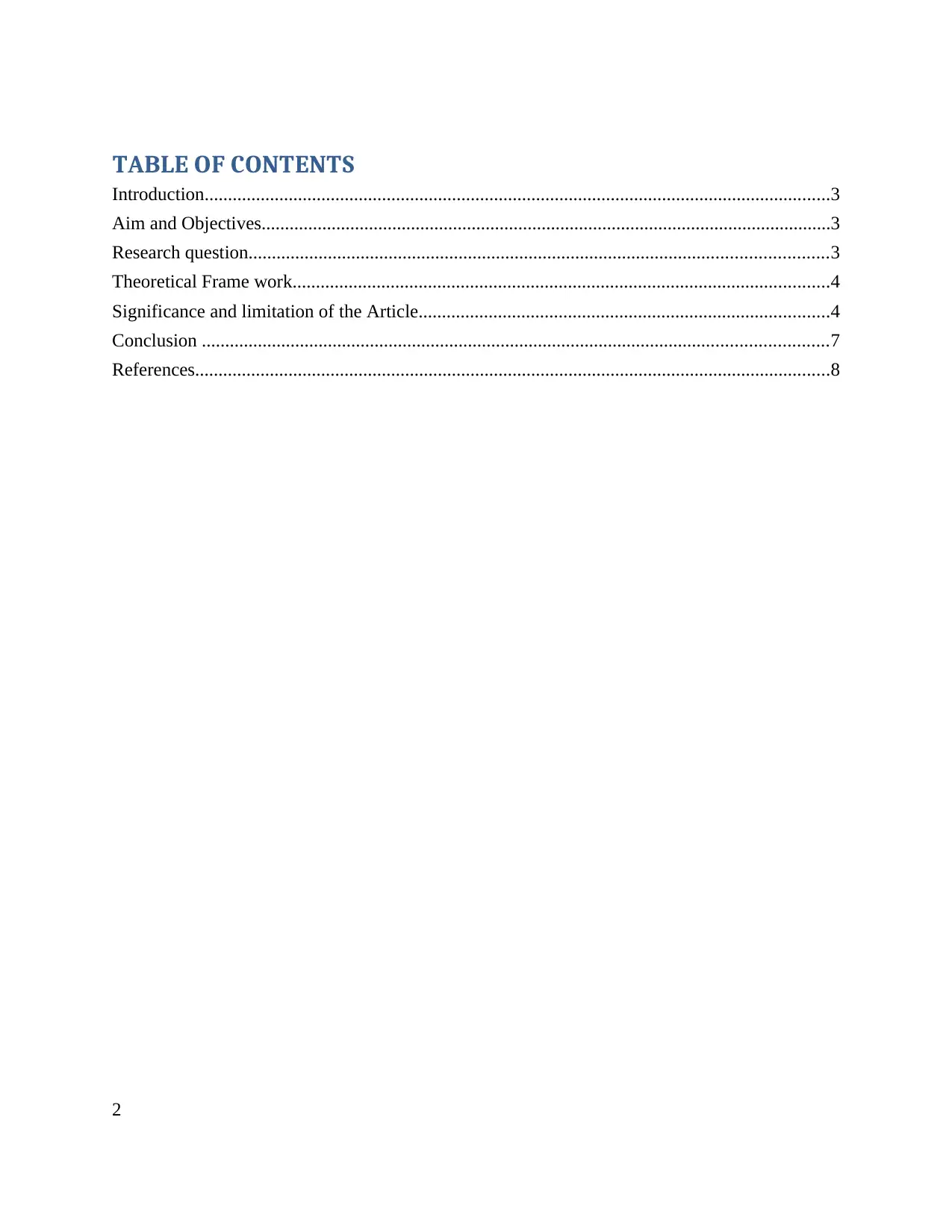
TABLE OF CONTENTS
Introduction......................................................................................................................................3
Aim and Objectives..........................................................................................................................3
Research question............................................................................................................................3
Theoretical Frame work...................................................................................................................4
Significance and limitation of the Article........................................................................................4
Conclusion ......................................................................................................................................7
References........................................................................................................................................8
2
Introduction......................................................................................................................................3
Aim and Objectives..........................................................................................................................3
Research question............................................................................................................................3
Theoretical Frame work...................................................................................................................4
Significance and limitation of the Article........................................................................................4
Conclusion ......................................................................................................................................7
References........................................................................................................................................8
2
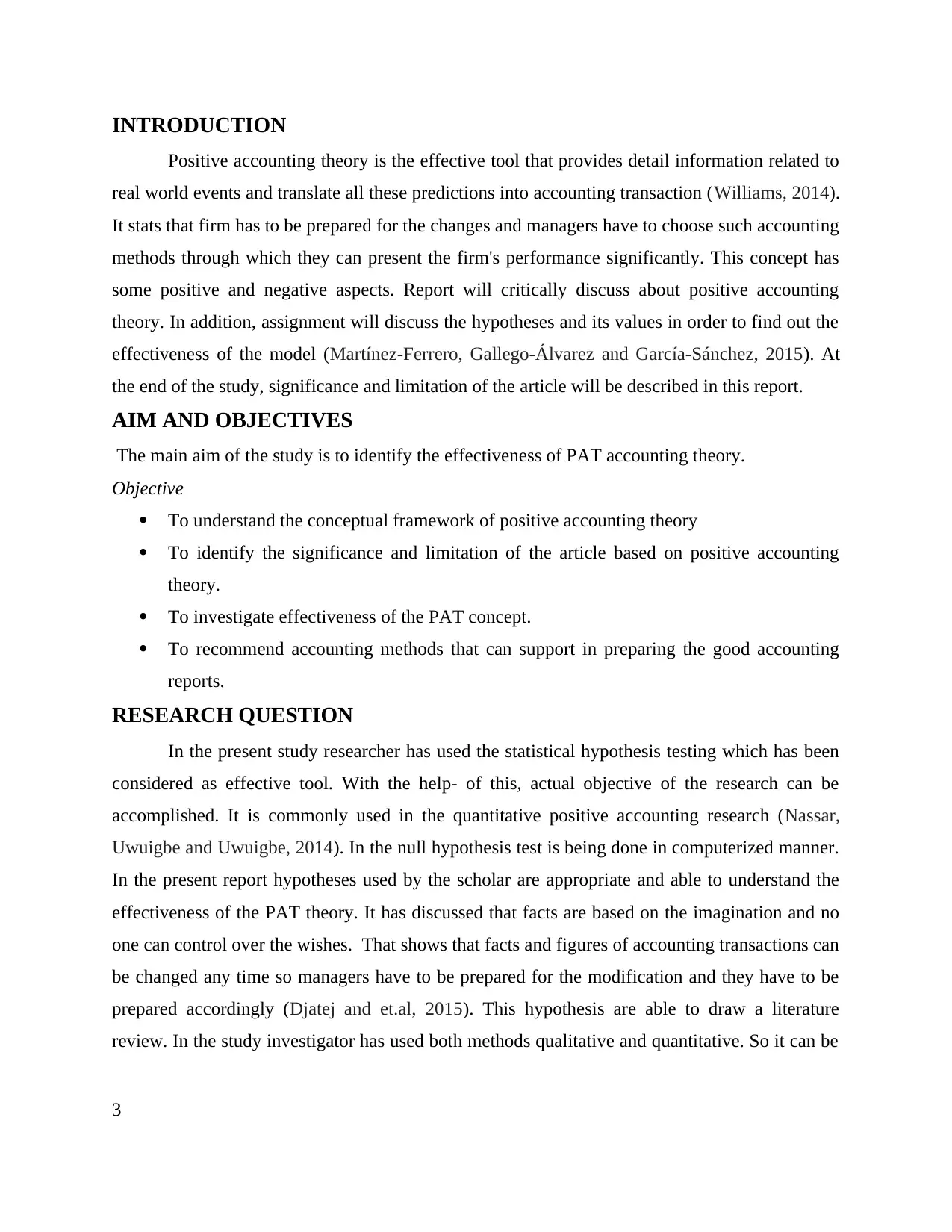
INTRODUCTION
Positive accounting theory is the effective tool that provides detail information related to
real world events and translate all these predictions into accounting transaction (Williams, 2014).
It stats that firm has to be prepared for the changes and managers have to choose such accounting
methods through which they can present the firm's performance significantly. This concept has
some positive and negative aspects. Report will critically discuss about positive accounting
theory. In addition, assignment will discuss the hypotheses and its values in order to find out the
effectiveness of the model (Martínez‐Ferrero, Gallego‐Álvarez and García‐Sánchez, 2015). At
the end of the study, significance and limitation of the article will be described in this report.
AIM AND OBJECTIVES
The main aim of the study is to identify the effectiveness of PAT accounting theory.
Objective
To understand the conceptual framework of positive accounting theory
To identify the significance and limitation of the article based on positive accounting
theory.
To investigate effectiveness of the PAT concept.
To recommend accounting methods that can support in preparing the good accounting
reports.
RESEARCH QUESTION
In the present study researcher has used the statistical hypothesis testing which has been
considered as effective tool. With the help- of this, actual objective of the research can be
accomplished. It is commonly used in the quantitative positive accounting research (Nassar,
Uwuigbe and Uwuigbe, 2014). In the null hypothesis test is being done in computerized manner.
In the present report hypotheses used by the scholar are appropriate and able to understand the
effectiveness of the PAT theory. It has discussed that facts are based on the imagination and no
one can control over the wishes. That shows that facts and figures of accounting transactions can
be changed any time so managers have to be prepared for the modification and they have to be
prepared accordingly (Djatej and et.al, 2015). This hypothesis are able to draw a literature
review. In the study investigator has used both methods qualitative and quantitative. So it can be
3
Positive accounting theory is the effective tool that provides detail information related to
real world events and translate all these predictions into accounting transaction (Williams, 2014).
It stats that firm has to be prepared for the changes and managers have to choose such accounting
methods through which they can present the firm's performance significantly. This concept has
some positive and negative aspects. Report will critically discuss about positive accounting
theory. In addition, assignment will discuss the hypotheses and its values in order to find out the
effectiveness of the model (Martínez‐Ferrero, Gallego‐Álvarez and García‐Sánchez, 2015). At
the end of the study, significance and limitation of the article will be described in this report.
AIM AND OBJECTIVES
The main aim of the study is to identify the effectiveness of PAT accounting theory.
Objective
To understand the conceptual framework of positive accounting theory
To identify the significance and limitation of the article based on positive accounting
theory.
To investigate effectiveness of the PAT concept.
To recommend accounting methods that can support in preparing the good accounting
reports.
RESEARCH QUESTION
In the present study researcher has used the statistical hypothesis testing which has been
considered as effective tool. With the help- of this, actual objective of the research can be
accomplished. It is commonly used in the quantitative positive accounting research (Nassar,
Uwuigbe and Uwuigbe, 2014). In the null hypothesis test is being done in computerized manner.
In the present report hypotheses used by the scholar are appropriate and able to understand the
effectiveness of the PAT theory. It has discussed that facts are based on the imagination and no
one can control over the wishes. That shows that facts and figures of accounting transactions can
be changed any time so managers have to be prepared for the modification and they have to be
prepared accordingly (Djatej and et.al, 2015). This hypothesis are able to draw a literature
review. In the study investigator has used both methods qualitative and quantitative. So it can be
3
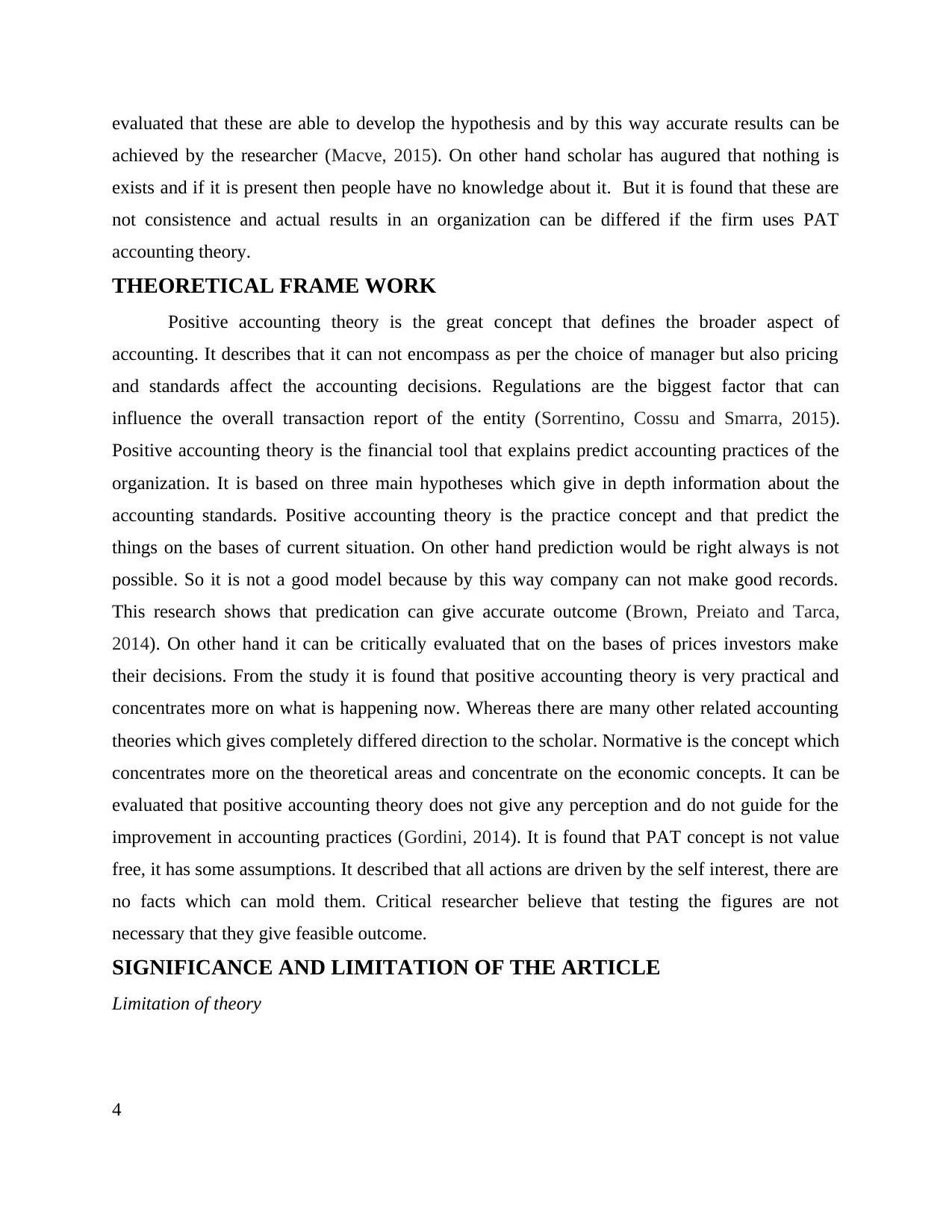
evaluated that these are able to develop the hypothesis and by this way accurate results can be
achieved by the researcher (Macve, 2015). On other hand scholar has augured that nothing is
exists and if it is present then people have no knowledge about it. But it is found that these are
not consistence and actual results in an organization can be differed if the firm uses PAT
accounting theory.
THEORETICAL FRAME WORK
Positive accounting theory is the great concept that defines the broader aspect of
accounting. It describes that it can not encompass as per the choice of manager but also pricing
and standards affect the accounting decisions. Regulations are the biggest factor that can
influence the overall transaction report of the entity (Sorrentino, Cossu and Smarra, 2015).
Positive accounting theory is the financial tool that explains predict accounting practices of the
organization. It is based on three main hypotheses which give in depth information about the
accounting standards. Positive accounting theory is the practice concept and that predict the
things on the bases of current situation. On other hand prediction would be right always is not
possible. So it is not a good model because by this way company can not make good records.
This research shows that predication can give accurate outcome (Brown, Preiato and Tarca,
2014). On other hand it can be critically evaluated that on the bases of prices investors make
their decisions. From the study it is found that positive accounting theory is very practical and
concentrates more on what is happening now. Whereas there are many other related accounting
theories which gives completely differed direction to the scholar. Normative is the concept which
concentrates more on the theoretical areas and concentrate on the economic concepts. It can be
evaluated that positive accounting theory does not give any perception and do not guide for the
improvement in accounting practices (Gordini, 2014). It is found that PAT concept is not value
free, it has some assumptions. It described that all actions are driven by the self interest, there are
no facts which can mold them. Critical researcher believe that testing the figures are not
necessary that they give feasible outcome.
SIGNIFICANCE AND LIMITATION OF THE ARTICLE
Limitation of theory
4
achieved by the researcher (Macve, 2015). On other hand scholar has augured that nothing is
exists and if it is present then people have no knowledge about it. But it is found that these are
not consistence and actual results in an organization can be differed if the firm uses PAT
accounting theory.
THEORETICAL FRAME WORK
Positive accounting theory is the great concept that defines the broader aspect of
accounting. It describes that it can not encompass as per the choice of manager but also pricing
and standards affect the accounting decisions. Regulations are the biggest factor that can
influence the overall transaction report of the entity (Sorrentino, Cossu and Smarra, 2015).
Positive accounting theory is the financial tool that explains predict accounting practices of the
organization. It is based on three main hypotheses which give in depth information about the
accounting standards. Positive accounting theory is the practice concept and that predict the
things on the bases of current situation. On other hand prediction would be right always is not
possible. So it is not a good model because by this way company can not make good records.
This research shows that predication can give accurate outcome (Brown, Preiato and Tarca,
2014). On other hand it can be critically evaluated that on the bases of prices investors make
their decisions. From the study it is found that positive accounting theory is very practical and
concentrates more on what is happening now. Whereas there are many other related accounting
theories which gives completely differed direction to the scholar. Normative is the concept which
concentrates more on the theoretical areas and concentrate on the economic concepts. It can be
evaluated that positive accounting theory does not give any perception and do not guide for the
improvement in accounting practices (Gordini, 2014). It is found that PAT concept is not value
free, it has some assumptions. It described that all actions are driven by the self interest, there are
no facts which can mold them. Critical researcher believe that testing the figures are not
necessary that they give feasible outcome.
SIGNIFICANCE AND LIMITATION OF THE ARTICLE
Limitation of theory
4
Secure Best Marks with AI Grader
Need help grading? Try our AI Grader for instant feedback on your assignments.
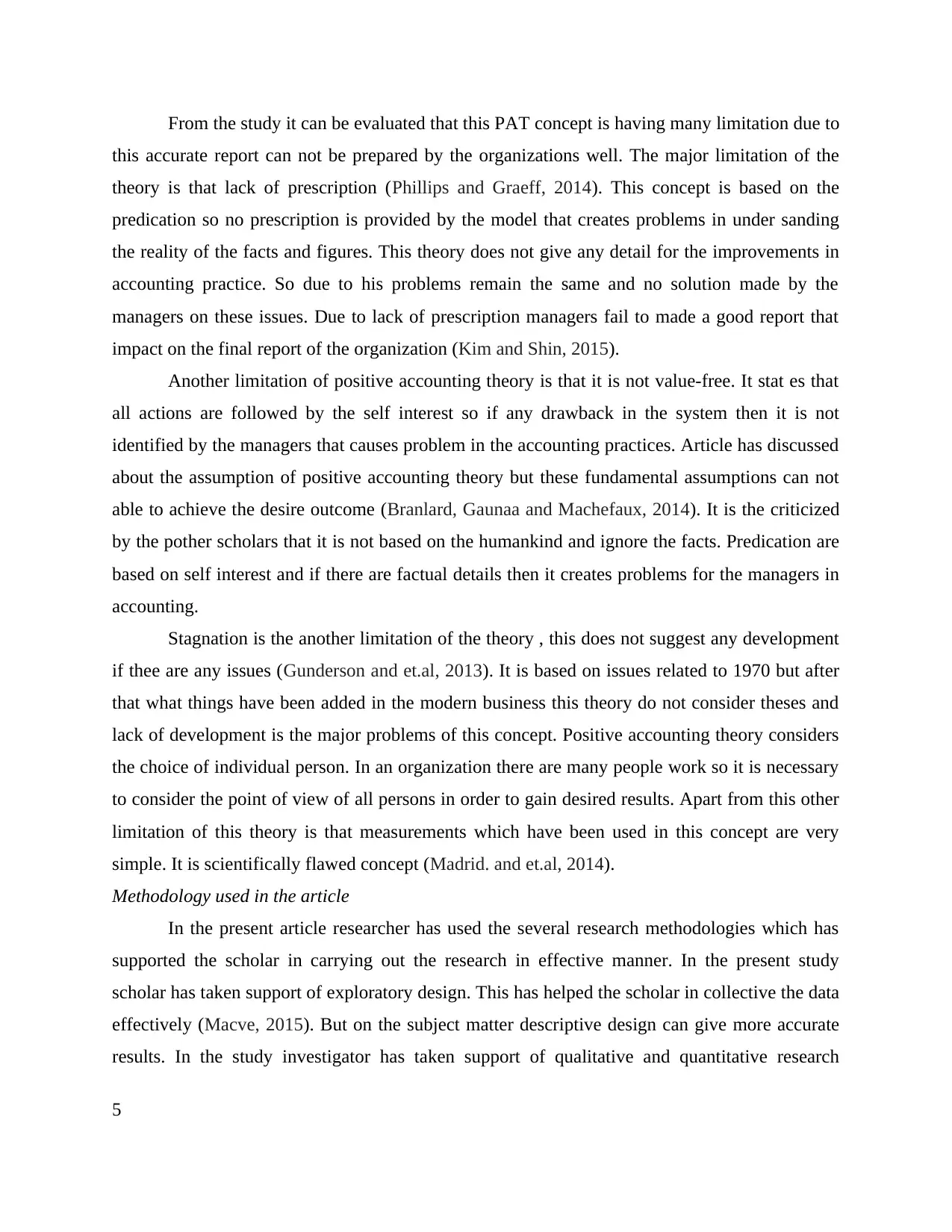
From the study it can be evaluated that this PAT concept is having many limitation due to
this accurate report can not be prepared by the organizations well. The major limitation of the
theory is that lack of prescription (Phillips and Graeff, 2014). This concept is based on the
predication so no prescription is provided by the model that creates problems in under sanding
the reality of the facts and figures. This theory does not give any detail for the improvements in
accounting practice. So due to his problems remain the same and no solution made by the
managers on these issues. Due to lack of prescription managers fail to made a good report that
impact on the final report of the organization (Kim and Shin, 2015).
Another limitation of positive accounting theory is that it is not value-free. It stat es that
all actions are followed by the self interest so if any drawback in the system then it is not
identified by the managers that causes problem in the accounting practices. Article has discussed
about the assumption of positive accounting theory but these fundamental assumptions can not
able to achieve the desire outcome (Branlard, Gaunaa and Machefaux, 2014). It is the criticized
by the pother scholars that it is not based on the humankind and ignore the facts. Predication are
based on self interest and if there are factual details then it creates problems for the managers in
accounting.
Stagnation is the another limitation of the theory , this does not suggest any development
if thee are any issues (Gunderson and et.al, 2013). It is based on issues related to 1970 but after
that what things have been added in the modern business this theory do not consider theses and
lack of development is the major problems of this concept. Positive accounting theory considers
the choice of individual person. In an organization there are many people work so it is necessary
to consider the point of view of all persons in order to gain desired results. Apart from this other
limitation of this theory is that measurements which have been used in this concept are very
simple. It is scientifically flawed concept (Madrid. and et.al, 2014).
Methodology used in the article
In the present article researcher has used the several research methodologies which has
supported the scholar in carrying out the research in effective manner. In the present study
scholar has taken support of exploratory design. This has helped the scholar in collective the data
effectively (Macve, 2015). But on the subject matter descriptive design can give more accurate
results. In the study investigator has taken support of qualitative and quantitative research
5
this accurate report can not be prepared by the organizations well. The major limitation of the
theory is that lack of prescription (Phillips and Graeff, 2014). This concept is based on the
predication so no prescription is provided by the model that creates problems in under sanding
the reality of the facts and figures. This theory does not give any detail for the improvements in
accounting practice. So due to his problems remain the same and no solution made by the
managers on these issues. Due to lack of prescription managers fail to made a good report that
impact on the final report of the organization (Kim and Shin, 2015).
Another limitation of positive accounting theory is that it is not value-free. It stat es that
all actions are followed by the self interest so if any drawback in the system then it is not
identified by the managers that causes problem in the accounting practices. Article has discussed
about the assumption of positive accounting theory but these fundamental assumptions can not
able to achieve the desire outcome (Branlard, Gaunaa and Machefaux, 2014). It is the criticized
by the pother scholars that it is not based on the humankind and ignore the facts. Predication are
based on self interest and if there are factual details then it creates problems for the managers in
accounting.
Stagnation is the another limitation of the theory , this does not suggest any development
if thee are any issues (Gunderson and et.al, 2013). It is based on issues related to 1970 but after
that what things have been added in the modern business this theory do not consider theses and
lack of development is the major problems of this concept. Positive accounting theory considers
the choice of individual person. In an organization there are many people work so it is necessary
to consider the point of view of all persons in order to gain desired results. Apart from this other
limitation of this theory is that measurements which have been used in this concept are very
simple. It is scientifically flawed concept (Madrid. and et.al, 2014).
Methodology used in the article
In the present article researcher has used the several research methodologies which has
supported the scholar in carrying out the research in effective manner. In the present study
scholar has taken support of exploratory design. This has helped the scholar in collective the data
effectively (Macve, 2015). But on the subject matter descriptive design can give more accurate
results. In the study investigator has taken support of qualitative and quantitative research
5

methods. Individual has used the figures and statistical data and also it has conducted the
interview from the manager of the firms so that optimistic results can be come out (Sorrentino,
Cossu and Smarra, 2015).
The major benefit of using quantitative tools are that with the help of this, scholar can get
accurate results and can find out the effectiveness of the theory. In the qualitative method scholar
has taken support of observation and has gathered the information by looking upon the
situational accounting practices of the companies (Djatej and et.al, 2015). Qualitative research
can be considered as mature study but most of the people think that positive and qualitative
researches are similar to each other, But the fact is that these both are very differed from each
other. The main reason of selecting the qualitative technique for the study on positive accounting
theory is that to develop understanding about the phenomenon. For that researcher has observed
the working of different auditors and their working pattern how they price an audit. Questions
have been asked related to subject matter in order to gain much knowledge about positive
accounting theory (Madrid. and et.al, 2014).
Limitations
Researcher has faced may limitation while working on the study on positive accounting
theory. The major problems faced by the scholar is lack of time. It was the main issue while
working on the articles due to this some points have not been addressed by the scholar well. This
was the problem faced by the investigator and due to lack of time duration persons fails to use
the advanced other mathematical formulas. Due to this accurate results do not addressed by the
researcher effectively (Gunderson and et.al, 2013). Apart from this another limitation in front of
scholar was that lack of funds. This was the major problems that has restricted the scholar and
individual fails to utilize the data well. This articles were not aligned that was the major
problems which has faced by the investigator. Because it was very difficult for the scholar to
understand the entire study and critically evaluate this in effective manner (Sorrentino, Cossu
and Smarra, 2015).
These all limitations were acknowledged by the researcher and that has affected the
results. Due to scared information main objective of the study that was investigate the
effectiveness of positive accounting theory is not been completely addressed by the researcher.
Author has concluded the study in effective manner (Madrid. and et.al, 2014). Individual has
6
interview from the manager of the firms so that optimistic results can be come out (Sorrentino,
Cossu and Smarra, 2015).
The major benefit of using quantitative tools are that with the help of this, scholar can get
accurate results and can find out the effectiveness of the theory. In the qualitative method scholar
has taken support of observation and has gathered the information by looking upon the
situational accounting practices of the companies (Djatej and et.al, 2015). Qualitative research
can be considered as mature study but most of the people think that positive and qualitative
researches are similar to each other, But the fact is that these both are very differed from each
other. The main reason of selecting the qualitative technique for the study on positive accounting
theory is that to develop understanding about the phenomenon. For that researcher has observed
the working of different auditors and their working pattern how they price an audit. Questions
have been asked related to subject matter in order to gain much knowledge about positive
accounting theory (Madrid. and et.al, 2014).
Limitations
Researcher has faced may limitation while working on the study on positive accounting
theory. The major problems faced by the scholar is lack of time. It was the main issue while
working on the articles due to this some points have not been addressed by the scholar well. This
was the problem faced by the investigator and due to lack of time duration persons fails to use
the advanced other mathematical formulas. Due to this accurate results do not addressed by the
researcher effectively (Gunderson and et.al, 2013). Apart from this another limitation in front of
scholar was that lack of funds. This was the major problems that has restricted the scholar and
individual fails to utilize the data well. This articles were not aligned that was the major
problems which has faced by the investigator. Because it was very difficult for the scholar to
understand the entire study and critically evaluate this in effective manner (Sorrentino, Cossu
and Smarra, 2015).
These all limitations were acknowledged by the researcher and that has affected the
results. Due to scared information main objective of the study that was investigate the
effectiveness of positive accounting theory is not been completely addressed by the researcher.
Author has concluded the study in effective manner (Madrid. and et.al, 2014). Individual has
6
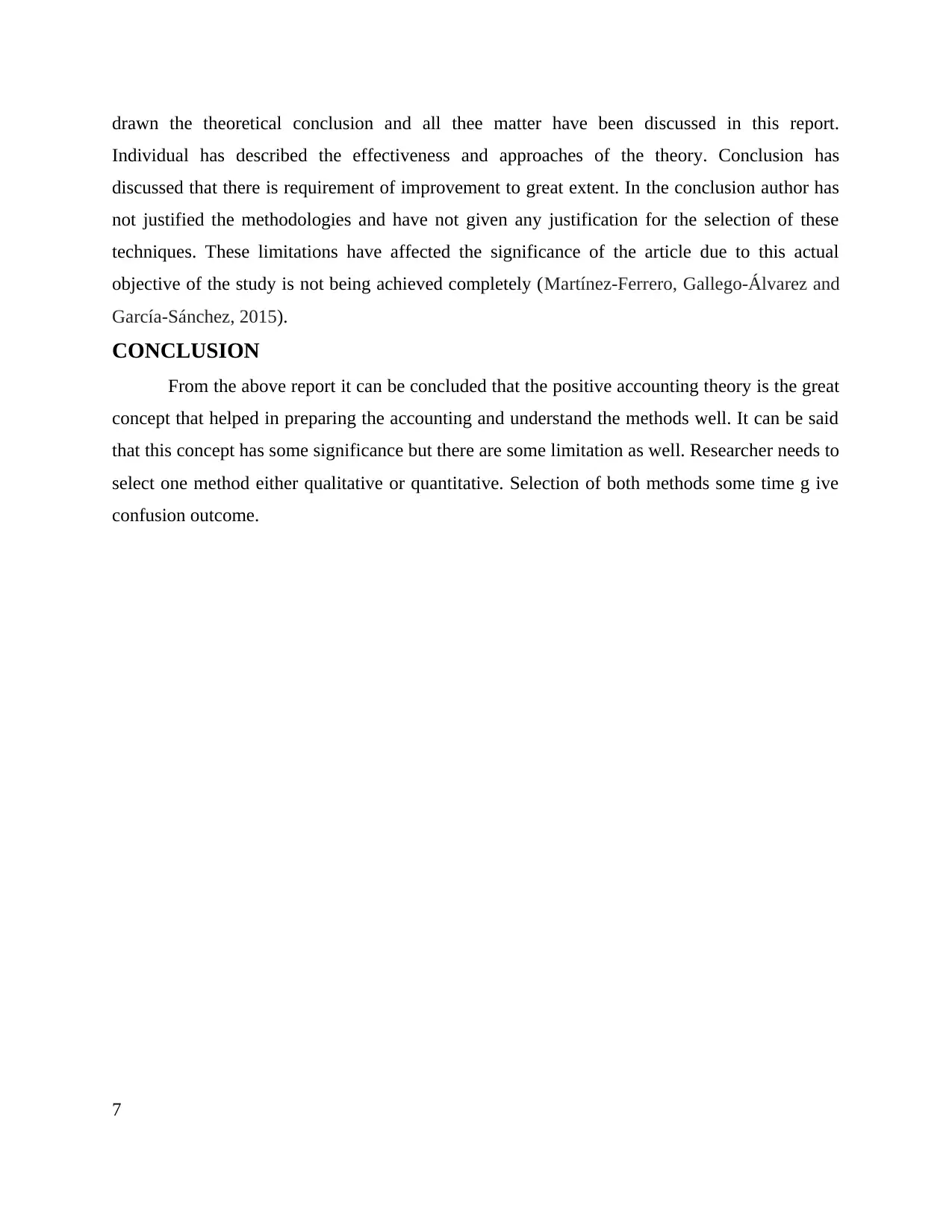
drawn the theoretical conclusion and all thee matter have been discussed in this report.
Individual has described the effectiveness and approaches of the theory. Conclusion has
discussed that there is requirement of improvement to great extent. In the conclusion author has
not justified the methodologies and have not given any justification for the selection of these
techniques. These limitations have affected the significance of the article due to this actual
objective of the study is not being achieved completely (Martínez‐Ferrero, Gallego‐Álvarez and
García‐Sánchez, 2015).
CONCLUSION
From the above report it can be concluded that the positive accounting theory is the great
concept that helped in preparing the accounting and understand the methods well. It can be said
that this concept has some significance but there are some limitation as well. Researcher needs to
select one method either qualitative or quantitative. Selection of both methods some time g ive
confusion outcome.
7
Individual has described the effectiveness and approaches of the theory. Conclusion has
discussed that there is requirement of improvement to great extent. In the conclusion author has
not justified the methodologies and have not given any justification for the selection of these
techniques. These limitations have affected the significance of the article due to this actual
objective of the study is not being achieved completely (Martínez‐Ferrero, Gallego‐Álvarez and
García‐Sánchez, 2015).
CONCLUSION
From the above report it can be concluded that the positive accounting theory is the great
concept that helped in preparing the accounting and understand the methods well. It can be said
that this concept has some significance but there are some limitation as well. Researcher needs to
select one method either qualitative or quantitative. Selection of both methods some time g ive
confusion outcome.
7
Paraphrase This Document
Need a fresh take? Get an instant paraphrase of this document with our AI Paraphraser

REFERENCES
Books and Journals
Branlard, E., Gaunaa, M. and Machefaux, E., 2014. Investigation of a new model accounting for
rotors of finite tip-speed ratio in yaw or tilt. In Journal of Physics: Conference Series (Vol.
524, No. 1, p. 012124). IOP Publishing.
Brown, P., Preiato, J. and Tarca, A., 2014. Measuring country differences in enforcement of
accounting standards: An audit and enforcement proxy.Journal of Business Finance &
Accounting. 41(1-2). pp.1-52.
Djatej, A. and et.al., 2015. UNDERSTANDING STUDENTS'MAJOR CHOICE IN
ACCOUNTING: AN APPLICATION OF THE THEORY OF REASONED
ACTION. Global Perspectives on Accounting Education. 12. pp.53.
Gordini, N., 2014. A genetic algorithm approach for SMEs bankruptcy prediction: Empirical
evidence from Italy. Expert Systems with Applications. 41(14). pp.6433-6445.
Gunderson, E.A. and et.al., 2013. Parent praise to 1‐to 3‐year‐olds predicts children's motivational
frameworks 5 years later. Child Development. 84(5). pp.1526-1541.
Kim, M. and Shin, Y., 2015. Collective efficacy as a mediator between cooperative group norms
and group positive affect and team creativity. Asia Pacific Journal of Management. 32(3).
pp.693-716.
Macve, R.H., 2015. Fair value vs conservatism? Aspects of the history of accounting, auditing,
business and finance from ancient Mesopotamia to modern China. The British Accounting
Review. 47(2). pp.124-141.
Madrid, H.P. and et.al., 2014. The role of weekly high‐activated positive mood, context, and
personality in innovative work behavior: A multilevel and interactional model. Journal of
Organizational Behavior. 35(2),. pp.234-256.
Martínez‐Ferrero, J., Gallego‐Álvarez, I. and García‐Sánchez, I.M., 2015. A Bidirectional
Analysis of Earnings Management and Corporate Social Responsibility: The Moderating
Effect of Stakeholder and Investor Protection.Australian Accounting Review. 25(4).
pp.359-371.
8
Books and Journals
Branlard, E., Gaunaa, M. and Machefaux, E., 2014. Investigation of a new model accounting for
rotors of finite tip-speed ratio in yaw or tilt. In Journal of Physics: Conference Series (Vol.
524, No. 1, p. 012124). IOP Publishing.
Brown, P., Preiato, J. and Tarca, A., 2014. Measuring country differences in enforcement of
accounting standards: An audit and enforcement proxy.Journal of Business Finance &
Accounting. 41(1-2). pp.1-52.
Djatej, A. and et.al., 2015. UNDERSTANDING STUDENTS'MAJOR CHOICE IN
ACCOUNTING: AN APPLICATION OF THE THEORY OF REASONED
ACTION. Global Perspectives on Accounting Education. 12. pp.53.
Gordini, N., 2014. A genetic algorithm approach for SMEs bankruptcy prediction: Empirical
evidence from Italy. Expert Systems with Applications. 41(14). pp.6433-6445.
Gunderson, E.A. and et.al., 2013. Parent praise to 1‐to 3‐year‐olds predicts children's motivational
frameworks 5 years later. Child Development. 84(5). pp.1526-1541.
Kim, M. and Shin, Y., 2015. Collective efficacy as a mediator between cooperative group norms
and group positive affect and team creativity. Asia Pacific Journal of Management. 32(3).
pp.693-716.
Macve, R.H., 2015. Fair value vs conservatism? Aspects of the history of accounting, auditing,
business and finance from ancient Mesopotamia to modern China. The British Accounting
Review. 47(2). pp.124-141.
Madrid, H.P. and et.al., 2014. The role of weekly high‐activated positive mood, context, and
personality in innovative work behavior: A multilevel and interactional model. Journal of
Organizational Behavior. 35(2),. pp.234-256.
Martínez‐Ferrero, J., Gallego‐Álvarez, I. and García‐Sánchez, I.M., 2015. A Bidirectional
Analysis of Earnings Management and Corporate Social Responsibility: The Moderating
Effect of Stakeholder and Investor Protection.Australian Accounting Review. 25(4).
pp.359-371.
8

Nassar, L., Uwuigbe, O.R. and Uwuigbe, U., 2014. IFRS Adoption and Its Integration into
Accounting Education Curriculum in Nigerian Universities.IFRS Adoption and Its
Integration into Accounting Education Curriculum in Nigerian Universities.
Phillips, M.E. and Graeff, T.R., 2014. Using an in-class simulation in the first accounting class:
moving from surface to deep learning. Journal of Education for Business. 89(5). pp.241-
247.
Sorrentino, M., Cossu, F. and Smarra, M., 2015. The “Production” of Accounting Information
Between Regulatory and Free Market Approach: An (Eternally) Open Issue. Journal of
Modern Accounting and Auditing. 11(1). pp.1-9.
Williams, P.F., 2014. The myth of rigorous accounting research. Accounting Horizons. 28(4).
pp.869-887.
9
Accounting Education Curriculum in Nigerian Universities.IFRS Adoption and Its
Integration into Accounting Education Curriculum in Nigerian Universities.
Phillips, M.E. and Graeff, T.R., 2014. Using an in-class simulation in the first accounting class:
moving from surface to deep learning. Journal of Education for Business. 89(5). pp.241-
247.
Sorrentino, M., Cossu, F. and Smarra, M., 2015. The “Production” of Accounting Information
Between Regulatory and Free Market Approach: An (Eternally) Open Issue. Journal of
Modern Accounting and Auditing. 11(1). pp.1-9.
Williams, P.F., 2014. The myth of rigorous accounting research. Accounting Horizons. 28(4).
pp.869-887.
9
1 out of 9
Related Documents
Your All-in-One AI-Powered Toolkit for Academic Success.
+13062052269
info@desklib.com
Available 24*7 on WhatsApp / Email
![[object Object]](/_next/static/media/star-bottom.7253800d.svg)
Unlock your academic potential
© 2024 | Zucol Services PVT LTD | All rights reserved.





